| Article ID | Journal | Published Year | Pages | File Type |
|---|---|---|---|---|
| 6384868 | Estuarine, Coastal and Shelf Science | 2014 | 8 Pages |
â¢Mechanisms involved in salt tolerance of Spartina densiflora were isolated and assessed.â¢High salinity causes oxidative stress in the leaves of S. densiflora.â¢This oxidative stress is counteracted by a specific antioxidant response.â¢The antioxidant system involves enhanced AA content and CAT and APX activities.â¢The antioxidant response seems to play a key role in conferring salt tolerance.
Halophytes usually have a robust antioxidative defense system to alleviate oxidative damage during salt stress. Spartina densiflora is a colonizing halophyte cordgrass, native of South America, which has become a common species in salt marshes of northern hemisphere, where it is ousting indigenous species. This study addressed salinity stress in S. densiflora; the occurrence of oxidative stress and the possible involvement of the antioxidative system in its high salt tolerance were studied. Plants were evaluated at in situ conditions, in the laboratory during a 28 day-acclimation period (AP) in clean substrate irrigated with a control salt content of 4 g Lâ1 (68 mM) and during a subsequent 28 day-treatment period (TP) exposed to different NaCl concentrations: control (68 mM), 428 mM or 680 mM. In the in situ setting, the high leave Na+ content was accompanied by high levels of hydroperoxides and reduced levels of total chlorophyll and carotenes, which correlated with enhanced activation of antioxidant defense biomarkers as total ascorbic acid (AA) content and guaiacol peroxidase (POD: EC 1.11.1.7)), catalase (CAT: EC 1.11.1.6) and ascorbate peroxidase (APX: EC 1.11.1.11) activities. Throughout the AP, leave Na+ and oxidative stress markers decreased concomitantly and reached stable low levels. During the TP, dose and time-dependent accumulation of Na+ in high NaCl-treated plants was concurrent with a decrease in content of total chlorophyll and carotenes and with an increase in the levels of total AA and CAT and APX activities. In conclusion, as hypothesized, high salinity induces conditions of oxidative stress in S. densiflora, so that its salt tolerance appears to be related to the implementation of a specific antioxidant response. This may account for Spartina densiflora's successful adaptation to habitats with fluctuating salinity and favour its phytoremediation potential.
